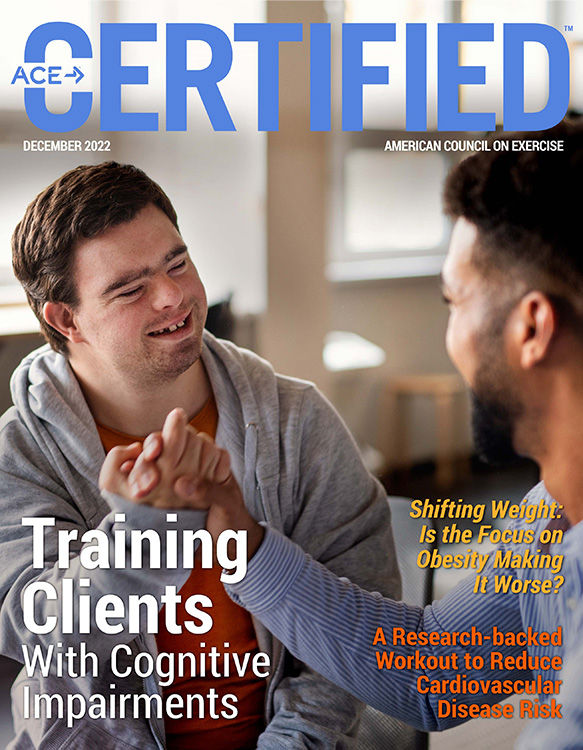
A Research-backed Workout to Reduce Cardiovascular Disease Risk

The American Council on Exercise has made getting people moving its primary mission, which is why it’s so important that health and exercise professionals have evidence-based programming options that can be delivered on both individual and community levels. To that end, ACE has supported a growing body of research that demonstrates the effectiveness of using the ACE Integrated Fitness Training® (ACE IFT®) Model to create personalized exercise programming that can be successfully implemented within a community setting. When combined with previous research, these studies suggest that implementing community-wide primary prevention initiatives that focus on increasing personalized exercise can serve to significantly reduce the burden of physical inactivity and its associated comorbidities in the community.
This article reviews one of these studies, which focused on community-based exercise programming to reduce cardiovascular disease risk. It also includes a sample workout demonstrating how to incorporate the exercise guidelines used in this ACE-supported research into your weekly routine for both cardiorespiratory and muscular training. ACE Certified Professionals have exclusive access to a printable PDF, which can be accessed via the button at the top of this page and given to clients to use on days when they aren’t training with you.
The ACE Integrated Fitness Training Model: A Review
The ACE IFT Model is a comprehensive system for exercise programming that pulls together the many training parameters required to be a successful health and exercise professional. It includes two distinct components: Cardiorespiratory Training and Muscular Training.
Cardiorespiratory programs have traditionally focused on steady-state training and been based on guidelines built around percentages of maximal heart rate, heart-rate reserve or oxygen uptake, or around descriptors like “moderate” or “vigorous” intensities. In contrast, the ACE IFT Model utilizes the individual’s ventilatory thresholds to truly personalize the program’s intensity.
When it comes to Muscular Training, the Model offers a continuum whereby the exerciser establishes postural stability and kinetic chain mobility and develops good movement patterns before adding external loads.
While previous research has demonstrated the effectiveness of the Model in a controlled setting, this study looked at how it might work in a real-world community setting.
One hundred and fifty participants were divided into a non-exercise control group and an exercise group, which completed a 12-week personalized exercise training program based on the ACE IFT Model. For the cardio sessions, a target heart rate that coincided with the person’s ventilatory threshold was established, and exercise workload was adjusted accordingly. For the muscular-training sessions, each participant’s five-repetition maximum (that is, the maximum amount of weight a person can lift five times, but no more) was used to establish and progress the program.
The researchers discovered that important measures of cardiometabolic health—including weight, waist circumference, blood pressure, high-density lipoprotein (HDL; i.e., “good”) cholesterol, triglycerides, blood glucose and cardiorespiratory fitness (as measured by VO2max)—showed statistically significant positive changes in the exercise group. Stated simply, this research confirms the effectiveness of the ACE IFT Model in improving health and fitness in a community setting.
Whether you work with individuals, small groups or in a defined community, these findings can be incorporated into your programming. The following workout illustrates how to incorporate the exercise guidelines used in this ACE-supported research into a client’s weekly routine for both cardiorespiratory and muscular training.
Cardiorespiratory Training
- Begin by focusing on establishing consistent exercise participation at a low-to-moderate intensity. The exercise intensity should be such that your client can talk comfortably in full sentences or can talk but not sing while training.
- Encourage your client to perform any amount of exercise to begin and gradually increase to performing 20 to 30 minutes of continuous exercise on most days of the week.
- After consistently performing that much exercise each week, continue to increase the duration of cardiorespiratory training sessions and begin to add brief higher-intensity intervals at an intensity where you the client can no longer talk comfortably. Also, consider adjusting the frequency and duration of exercise.
- Eventually, more intense intervals can be added until the client reaches an intensity where talking in complete sentence is not possible.
- Overall, the focus is to keep exercise enjoyable and to gradually increase the frequency and duration of exercise. The exercise intensity can be increased and monitored by gauging the client’s ability to talk. Stated simply, if an individual can talk comfortably, they are working at a moderate intensity; when talking becomes uncomfortable, they are working at a vigorous intensity; and when they definitely cannot talk, they are working at an intensity that is near maximal or maximal. Begin low and slow and gradually add brief intervals to the exercise routine.
Muscular Training
- Perform this workout two or three times per week on nonconsecutive days.
- Perform each exercise for 12 repetitions. If the exercise uses an external load, be sure to select a weight that allows the individual to complete about 12 repetitions. In other words, if a client can only do eight repetitions, decrease the amount of weight used; if they can do 20 repetitions, a heavier load is needed.
- Progress the load for weighted exercises by 5% every two weeks or at any time when more than 12 repetitions can be completed.
- For body-weight exercises, increase the number of repetitions by 5 to 10% every two weeks.
- Perform two sets of each exercise.
Exercises
|
Stability Ball Circuit |
Expand Your Knowledge
 |
Exercise Programming Toolkit – Course BundleThe ACE Integrated Fitness Training® (ACE IFT®) Model is a program design blueprint that has evolved with the needs of today’s exercise professionals and their clients. The ACE IFT Exercise Programming Toolkit course bundle explores the different components of the ACE IFT Model, including the ACE Mover Method, to help you develop safe and effective exercise plans. By gaining an understanding of how to move through the phases of the ACE IFT Model, you will be able to effectively educate clients and gain their trust, keeping them safe as they move toward their goals. |

More Articles
- Certified™: December 2022
Training Clients With Cognitive Impairments: Triggers, Behaviors and How to Respond
Contributor
- Certified™: December 2022
More Than Tired: What You Need to Know About Fatigue
- Certified™: December 2022
Shifting Weight: Is the Focus on Obesity Making It Worse?
Contributor
- Certified™: December 2022




 by
by 

